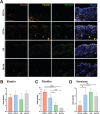The antifibrotic adipose-derived stromal cell: Grafted fat enriched with CD74+ adipose-derived stromal cells reduces chronic radiation-induced skin fibrosis
- PMID: 32563212
- PMCID: PMC7581454
- DOI: 10.1002/sctm.19-0317
The antifibrotic adipose-derived stromal cell: Grafted fat enriched with CD74+ adipose-derived stromal cells reduces chronic radiation-induced skin fibrosis
Abstract
Fat grafting can reduce radiation-induced fibrosis. Improved outcomes are found when fat grafts are enriched with adipose-derived stromal cells (ASCs), implicating ASCs as key drivers of soft tissue regeneration. We have identified a subpopulation of ASCs positive for CD74 with enhanced antifibrotic effects. Compared to CD74- and unsorted (US) ASCs, CD74+ ASCs have increased expression of hepatocyte growth factor, fibroblast growth factor 2, and transforming growth factor β3 (TGF-β3) and decreased levels of TGF-β1. Dermal fibroblasts incubated with conditioned media from CD74+ ASCs produced less collagen upon stimulation, compared to fibroblasts incubated with media from CD74- or US ASCs. Upon transplantation, fat grafts enriched with CD74+ ASCs reduced the stiffness, dermal thickness, and collagen content of overlying skin, and decreased the relative proportions of more fibrotic dermal fibroblasts. Improvements in several extracellular matrix components were also appreciated on immunofluorescent staining. Together these findings indicate CD74+ ASCs have antifibrotic qualities and may play an important role in future strategies to address fibrotic remodeling following radiation-induced fibrosis.
Keywords: FACS; adipose; adipose stem cells; stem cells; transplantation.
© 2020 The Authors. STEM CELLS TRANSLATIONAL MEDICINE published by Wiley Periodicals, Inc. on behalf of AlphaMed Press.
Conflict of interest statement
N.M.D.D. declared research funding from California Institute for Regenerative Medicine. R.N. declared consultant/advisory role with Mentor Worldwide, Musculoskeletal Transplant Foundation, Telabio, Inc. A.M. declared consultant/advisory for Allergan, AxoGen, Sientra, and Stryker and research funding from AxoGen. The other authors declared no potential conflicts of interest.
Figures





References
-
- Mukesh MB, Barnett GC, Wilkinson JS, et al. Randomized controlled trial of intensity‐modulated radiotherapy for early breast cancer: 5‐year results confirm superior overall cosmesis. J Clin Oncol. 2013;31(36):4488‐4495. - PubMed
-
- Mukesh MB, Harris E, Collette S, et al. Normal tissue complication probability (NTCP) parameters for breast fibrosis: pooled results from two randomised trials. Radiother Oncol. 2013;108(2):293‐298. - PubMed
-
- Mukesh M, Harris E, Jena R, Evans P, Coles C. Relationship between irradiated breast volume and late normal tissue complications: a systematic review. Radiother Oncol. 2012;104(1):1‐10. - PubMed
-
- Whelan TJ, Pignol J‐P, Levine MN, et al. Long‐term results of hypofractionated radiation therapy for breast cancer. N Engl J Med. 2010;362(6):513‐520. - PubMed
-
- Pignol J‐P, Truong P, Rakovitch E, Sattler MG, Whelan TJ, Olivotto IA. Ten years results of the Canadian breast intensity modulated radiation therapy (IMRT) randomized controlled trial. Radiother Oncol. 2016;121(3):414‐419. - PubMed
Publication types
MeSH terms
Substances
Grants and funding
LinkOut - more resources
Full Text Sources
Medical

